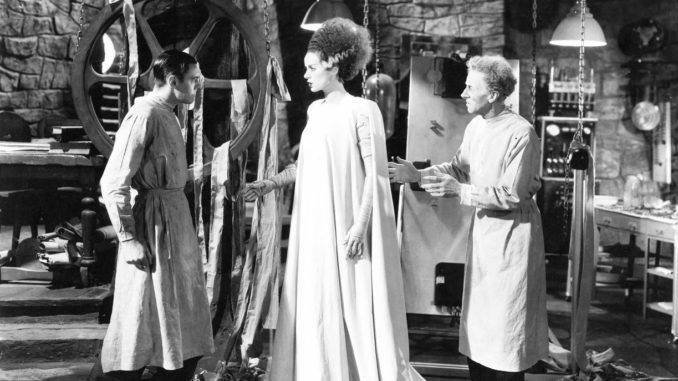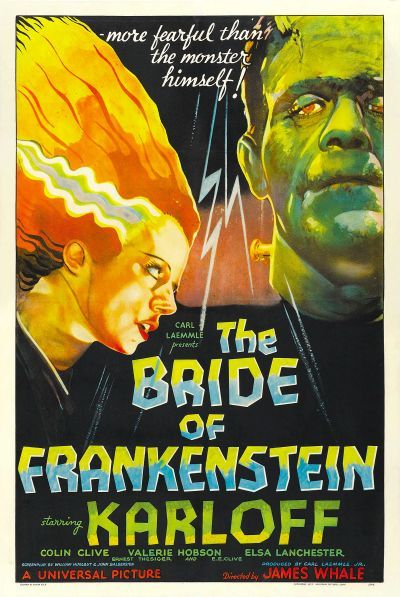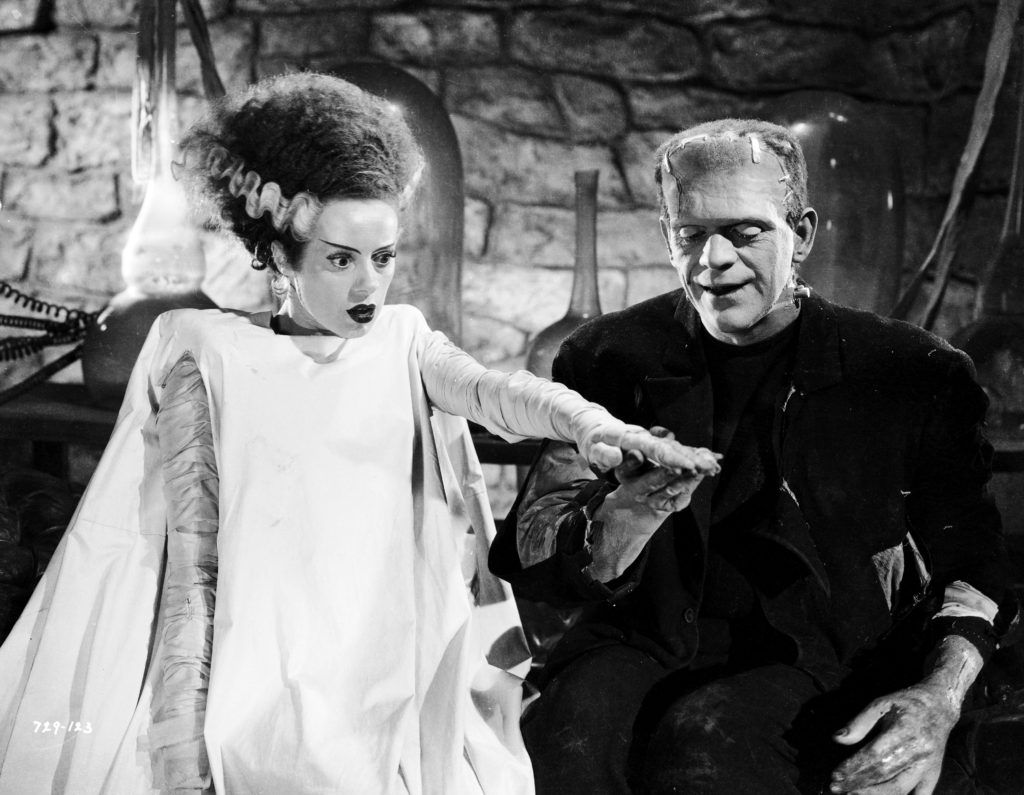
Rating: B+
Dir: James Whale
Star: Boris Karloff, Colin Clive, Ernest Thesiger, Elsa Lanchester
#WellActually Shouldn’t the title be “Bride of Frankenstein’s Monster“? Because I was informed by every pedant on the Internet, that Frankenstein is not the name of the creature, but only his creator. Yet here, it’s clear the female creature is 100% intended to be a mate for the monster, played again by Karloff. But I guess the “of” could indicate creatorship more than matrimony. “Bride for Frankenstein” would have made things considerably clearer. Oh, well. The idea for this one dates back to Mary Shelley’s original novel. There, the monster is far more conversational, and makes the case himself to Frankenstein: “Shall each man find a wife for his bosom, and each beast have his mate, and I be alone?’
His argument initially convinces the scientist, only to backtrack at the thought of potential baby creatures. He abandons the project part way, causing the male part of the experiment to take terrible, if fitting, revenge. In the movie, we begin with a prologue where Shelley (Lanchester) recounts the story to Lord Byron and her husband, getting the “some things with which mankind was not meant to meddle” moral out there early, before we cut back to the finale of the 1931 movie. It turns out neither Henry Frankenstein (Clive), nor his creature (Karloff), died in the burning windmill as originally depicted. Henry has realized the creature – off roaming the local countryside – was a bad idea, but is still interested in the field.
 With the monster not around to make the case eloquently himself, it’s left to the mentor of Henry Frankenstein (Clive), Doctor Septimus Pretorius (Thesiger) to propose the creation of a female counterpart. This would use an artificial brain grown by Pretorius, and body parts acquired by Frankenstein. Henry is initially unwilling, and is largely coerced by Septimus. The doctor won’t take no for an answer, first using the threat of exposure, then the kidnap of Henry’s wife, Elizabeth (Valerie Hobson), to get his acolyte onside. Needless to say, the prologue proves entirely accurate, with the Bride (also Lanchester), deciding she wants no part of her intended spouse, triggering the violent rage in her jilted fiancé, who proceeds on another rampage of murderous destruction. That mob with torches wasn’t wrong, were they?
With the monster not around to make the case eloquently himself, it’s left to the mentor of Henry Frankenstein (Clive), Doctor Septimus Pretorius (Thesiger) to propose the creation of a female counterpart. This would use an artificial brain grown by Pretorius, and body parts acquired by Frankenstein. Henry is initially unwilling, and is largely coerced by Septimus. The doctor won’t take no for an answer, first using the threat of exposure, then the kidnap of Henry’s wife, Elizabeth (Valerie Hobson), to get his acolyte onside. Needless to say, the prologue proves entirely accurate, with the Bride (also Lanchester), deciding she wants no part of her intended spouse, triggering the violent rage in her jilted fiancé, who proceeds on another rampage of murderous destruction. That mob with torches wasn’t wrong, were they?
Chris tells a story from the seventies about her martial arts class going to see Enter the Dragon. Everyone else sat there reverentially, but Chris was laughing like a fiend, and was eventually asked to leave. The problem was, she had never seen Dragon. She had, however, seen Kentucky Fried Movie, with its blistering parody, A Fistful of Yen, and was unable to take its target seriously. I can relate: Excalibur was ruined for me by Holy Grail. And the Frankenstein franchise is similarly derailed by Mel Brooks. You can’t watch the monster bond with a blind man here, and not think of Gene Hackman stumbling around in Young Frankenstein. Yet there’s a fair bit here which almost seems to teeter on self-parody.
In particular, some of the performances appear either self-aware or scenery-chewing to the max. Witness the comedic excesses of Una O’Connor as housekeeper Minnie, which would not be out of place in one of the less subtle Carry On movies. Or Young Frankenstein. Clive often comes across as overwrought – or perhaps drunk – and Thesiger seems to be playing half his scenes with a knowing wink. I got a distinct Quentin Crisp vibe from him, perhaps in part because Crisp played a similar role to Pretorius in 1985’s The Bride, opposite Sting, Jennifer Beals and Clancy Brown. The sharp shifts in tone here take a little bit of getting used to, and I did not feel the emotional components worked as well as they might.
However, there’s an enormous amount here to appreciate and enjoy, once you settle in and get in line with the film’s tone. Indeed, this is certainly among the most enjoyable entries I’ve seen in this series. There are points where the look of the movie simply does not feel like you’re watching something close to ninety years old. The re-animation sequence which brings the Bride to life is particularly strong in this regard, and remains impressive in its pacing, editing and composition. The sets here are gorgeous too, even the ones which are clearly supposed to be forests. There have been entries in this feature where I’ve been hard-pushed to find decent stills. Not the case here, where I could capture almost any frame, and it would do the job well (below).
 Technically, my main gripe would be Dr. Pretorius’s little people. The Devil-Doll did it much better not long after this, and the homunculi don’t even prove of relevance to the plot here. They could be excised entirely, though it’d leave the movie running really short. I’m somewhat ambivalent about the monster being able to talk in the sequel, and understand Karloff was uncertain as well. I think it does give a little bit of pathos to the character, and there’s no denying the impact at the end when he mournfully pronounces, “We belong dead.” Sorry, Frankie: not if the box-office returns decide otherwise, as it would four years later.
Technically, my main gripe would be Dr. Pretorius’s little people. The Devil-Doll did it much better not long after this, and the homunculi don’t even prove of relevance to the plot here. They could be excised entirely, though it’d leave the movie running really short. I’m somewhat ambivalent about the monster being able to talk in the sequel, and understand Karloff was uncertain as well. I think it does give a little bit of pathos to the character, and there’s no denying the impact at the end when he mournfully pronounces, “We belong dead.” Sorry, Frankie: not if the box-office returns decide otherwise, as it would four years later.
There isn’t a lot of slack here (outside the homunculi), with a lot to cram into its seventy-five minutes. You may be surprised at how little the Bride is actually visible on screen. You see more of Elsa Lanchester as Mary Shelley, though for whatever reason, she resembles a Lady Gaga look-alike contestant. But the Bride’s style is iconic, and still used as a basis for memes the best part of a century later. Obviously, the arrival of the Hays Code – this was tagged with Certificate Number 768, which made me laugh for some reason – since the first movie did have an impact. Perhaps less than you might expect, and there is still some surprising imagery, paralleling the monster and Jesus. The term “classic” gets thrown around a lot. This deserves it.
This article is part of our October 2025 feature, 31 Days of Vintage Horror.
